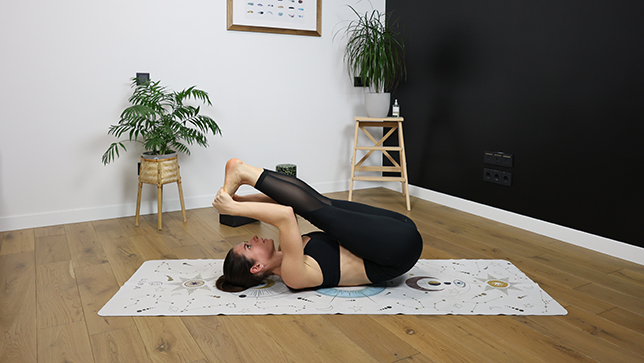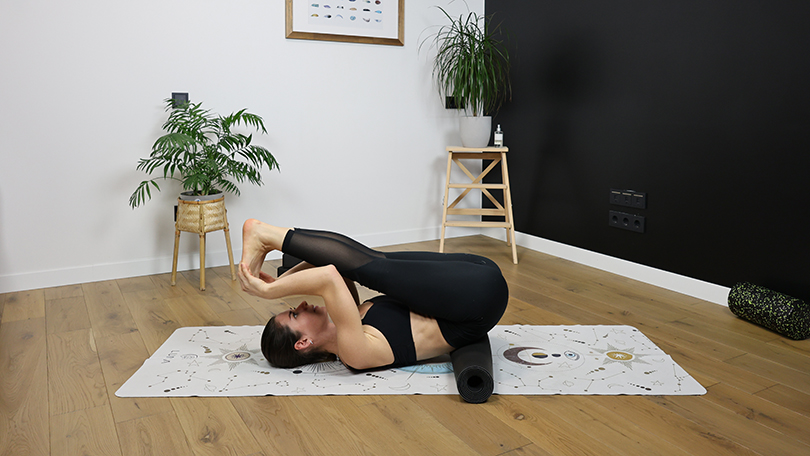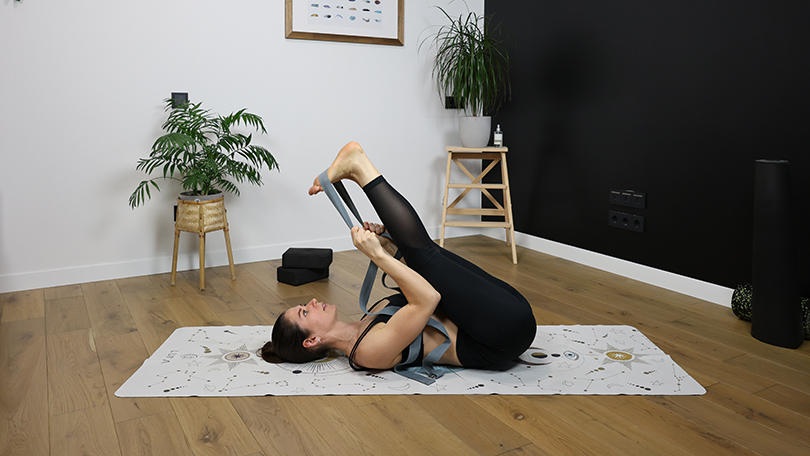Reclined Intense Back Stretch Pose - Supta Paschimottanasana

Contents
Reclined Intense Back Stretch Pose or Supta Paschimottanasana (soup-tah pah-shee-mote-tahn-ah-sah-nah) is a basic reclined asana that provides a strong hamstring stretch. The name comes from the Sanskrit supta, meaning “reclined”; paschim, which means “west” and refers to the back of the body; uttana, which means “stretched out”; and asana, meaning “pose.”
In Supta Paschimottasana, the yogi lies on their back and folds at the hips so that the straight legs lift overhead and continue to drop toward the forehead while the hands grasp the big toes. It resembles paschimottanasana, or seated forward bend, but done lying on one’s back.
Pose Detail
- By Type: Balancing Yoga Poses, Flexibility Yoga Poses
- Difficulty: Beginners, Intermediate
- Body Position: Forward Bend Yoga Poses, Supine Yoga Poses
- By Benefit: Yoga Poses For Digestion, Yoga Poses For Neck Pain
Step-by-Step Instructions
Benefits and Contraindications
This is a great hamstring and lower back stretch
Can ease constipation
Can help with the alignment and positioning of the spine
This pose is part of a Yoga for Back Pain sequence
Promoting Digestion
Helps relieve headache
Pregnancy and menstruating
Hernia and sciatica
Injury in hips, back, spine, shoulders, neck, or legs
Gastrointestinal issues
Vertigo
Asthma
Modifications and Props for Beginners
- While bending from the hips, after bringing your knees to the chest, you can put a bolster, yoga block, or cushion near your tailbone for support to your lower back and hips.
- If you cannot fully bring your legs to the back of your head, do not force your body. Start by bringing the legs halfway and use a strap to gradually achieve the leg positioning. Keep your hands near the back of the knees to support holding your legs in the halfway position.
- Place a folded blanket in a way that provides a cushion to the neck and shoulder blades.

- Put a chair behind your head to place your feet if you are unable to bring your feet completely towards the back.
- If you know that you have a badly stretched back surface of the thigh, then you can use a strap. hook the strap to the foot and pull it towards you with a light tension.ʼ

Useful Tips
- As you move into the pose, focus on your breath and try to relax your body. Use your exhale to release any tension or tightness in your muscles.
- While you’re in the pose, engage your core muscles to help support your lower back. This will help to prevent any strain or discomfort in this area.
Frequently Asked Questions
Yes, Supta Paschimottanasana is generally safe for beginners. However, it’s important to practice with proper alignment and listen to your body to avoid any strain or injury.
If you have lower back pain, it’s important to practice with caution and consult with a healthcare professional or a qualified yoga teacher before attempting the pose. You may need to modify the pose or practice with the support of props.
You can hold Supta Paschimottanasana for 5-10 deep breaths, or longer if it feels comfortable for you. It’s important to allow your body to relax and release tension with each exhale.
Some common mistakes to avoid include rounding your spine, forcing the stretch, and holding your breath. Remember to practice with proper alignment, move slowly and mindfully, and breathe deeply throughout the pose.
Variations
- Reclined Intense Back Stretch Pose With A Strap
- Reclined Intense Back Stretch Pose With A Bolster
- Reclined Intense Back Stretch Pose One leg at A Time
- Reclined Intense Back Stretch Pose Legs up the wall variation